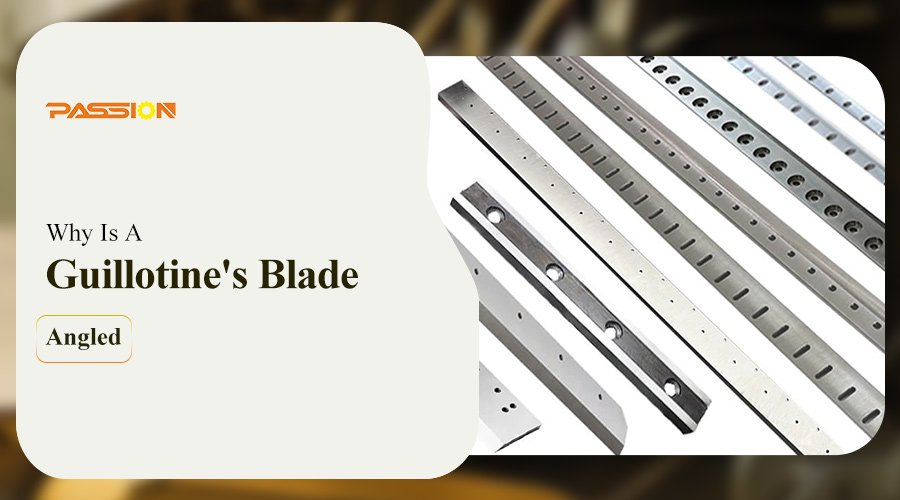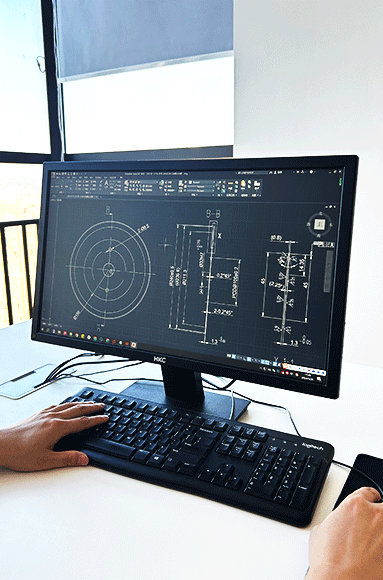Many buyers in the corrugated industry will often use or purchase cross cut guillotine knives. In the process of using it, the knife blade is found to be inclined. Inevitably, the question will be raised as to why its blade is designed to be inclined.
After two weeks of researching information and browsing many websites, it took 6 hours to put together the answer to explain why the knife was designed to be angled.
The answer is: the angled design of guillotine blades is considered for a number of reasons, including increased cutting efficiency, reduced rebound and technical considerations.
Next, we continue to discuss the topic of guillotine blade.
What factors are taken into account in the design of the guillotine blade inclination?
Cutting Efficiency: The angled blade design makes the cutting action more ‘slicing’ than ‘chopping’, which is more efficient. When the blade is dropped at an angle (e.g., the common 45-degree angle), it cuts more smoothly, reducing resistance and unnecessary energy loss during the cutting process.
Reduced Rebound: The angled blade reduces rebound due to impact during the cutting process. Once the blade has fully penetrated the object, due to its angled design, the blade is less likely to bounce back due to reaction forces, thus ensuring a swift and thorough cut.
Technical Considerations: The designers of guillotines blades may have taken other technical factors into account during the design process, such as the durability and sharpness of the blade and the cost of maintenance. An angled blade may be easier to keep sharp and also less likely to break during use.
Why is the upper blade of a guillotine fixed at an angle to the lower blade?
The design of the upper blade of the corrugated paper cross cutting knife at an angle to the lower blade is mainly based on the following considerations:
Improve cutting efficiency
Cutting Mechanics: The angled blade design concentrates the cutting force more effectively at the tip of the blade, making the cutting process smoother. This design reduces resistance and friction during cutting, thus improving cutting efficiency.
Blade Contact Area: During the cutting process, the upper and lower blades contact the corrugated paper at an angle, which reduces the contact area between the blade and the paper, thereby reducing the energy required for cutting and increasing cutting speed.
Ensuring Cutting Quality
Cutting Accuracy: The angled blade design helps ensure cutting accuracy. When the blade cuts at an angle, it can more accurately control the cutting path and reduce deviation, thus ensuring the flatness and consistency of the cut edge.
Avoiding Paper Damage: A proper blade angle reduces damage to the corrugated paper structure, avoids burrs and tears during the cutting process, and improves cutting quality.
Extend blade life
Reduced Wear And Tear: The angled blade design helps to disperse the stress during the cutting process and reduces direct friction between the blade and the paper, thus reducing the wear rate of the blade and extending its service life.
Easy Maintenance: due to the high cutting efficiency and quality, it reduces the maintenance cost and time cost caused by frequent replacement of blades or adjustment of equipment parameters.
Adaptable to different paper types
Flexibility: There are many types of corrugated paper with different thicknesses, hardnesses and other characteristics. The inclined blade design can be adjusted for different paper types to suit different cutting needs.
Optimised Cutting Effect: By adjusting the angle and position of the blade, the best cutting effect can be achieved for corrugated paper of different thicknesses, ensuring that the edges of the cut paper are flat and burr-free.
In summary, the upper and lower blades of the corrugated paper cutting knife are designed at an angle in order to improve cutting efficiency, ensure cutting quality, extend blade service life and adapt to the needs of different paper types. This design is based on long-term practical experience and scientific cutting principles, and is of great significance in improving corrugated paper processing efficiency and product quality.
What is the mechanism of a guillotine paper cutter?
The working mechanism of the Guillotine paper cutter is based on the principle of mechanical mechanics, whereby a vertically downward-facing blade cuts the paper to achieve a fast and precise cut. Here is an explanation of the mechanism:
Principle of operation
Blade Design: The heart of a Guillotine paper cutter is the sharp blade, which is usually designed to be heavy-duty and robust to ensure that it is able to cut a wide range of paper or material thicknesses. The blade is usually mounted at one end of the machine and can be moved vertically.
Guiding Systems: To ensure stability and accuracy of the blade during the cutting process, sophisticated guiding systems are installed inside the machine. These guides, usually consisting of sturdy columns or rails, are used to guide the blade vertically along a straight path.
Power Source: The power source of a Guillotine paper cutter can be manual or electric. Manual machines drive the blade down by manually pushing a lever or handle, whereas electric machines rely on an electric motor to provide power, which translates the rotational motion of the motor into vertical movement of the blade through a transmission mechanism.
Cutting Process: Once the paper is placed and positioned on the table of the machine, the blade starts to fall vertically, driven by the power source. The blade passes precisely through the paper along the guiding system, cutting it into the desired size and shape. Once the cut is complete, the blade is automatically reset to its initial position, ready for the next cut.
Features and Benefits
High Precision: Thanks to the precise guiding system and sharp blades, the Guillotine paper cutter is able to achieve highly accurate cutting results for a wide range of fine cutting needs.
High Efficiency: the motorised Guillotine paper cutter has a high cutting speed, which significantly improves work efficiency and makes it particularly suitable for cutting large quantities of paper.
Good Safety: Modern Guillotine paper cutters are usually equipped with safety guards, such as guards, emergency stop buttons, etc., to ensure the safety of the operator.
Wide Range Of Applications: Guillotine paper cutters are not only suitable for paper cutting, but can also be used to cut fabric, plastic film, leather and many other materials.
Summary
The angled design of guillotine blades is motivated by a number of factors such as increased cutting efficiency, reduced backlash and technical considerations. Guillotine paper blade achieves efficient and precise cutting effect through its unique blade design and precise guiding system, and has been widely used in many fields.



